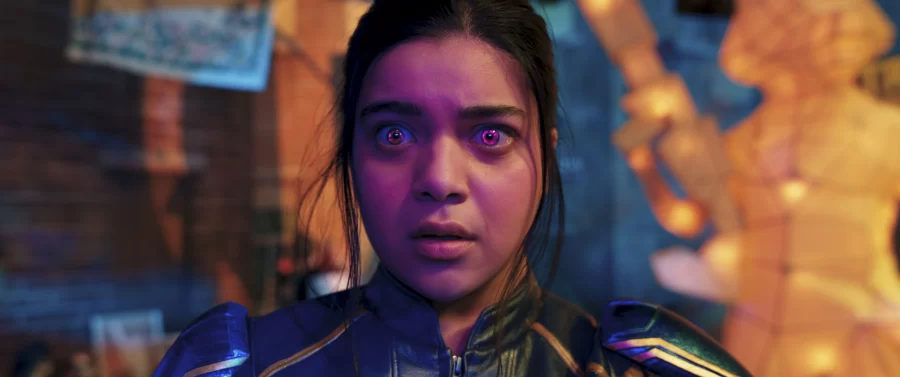DI Voices | Rating South Asian representation in television | Part I
Photo courtesy of Marvel Studios/TNS
Iman Vellani as Ms. Marvel/Kamala Khan in Marvel Studios’ Disney+ show “Ms. Marvel” that premiered on June 8, 2022.
Nov 17, 2022
There was a sore lack of South Asian representation in mainstream media when I was growing up. The only representation I had was Ravi from “Jessie,” who did more harm than good in terms of representation. He was a caricature of what people thought South Asians are like: losers and nerds with heavy accents.
However, in the past few years, popular media has been created with South Asian people in front of and behind the camera. My main focuses in part one are “Never Have I Ever” and “Ms. Marvel,” and part two will examine “Bridgerton.” They each work differently to provide Desi people the representation we’ve needed.
“Never Have I Ever” — Three stars
The first true South Asian main character in a teen television comedy came in 2020 with Devi Vishwakumar from “Never Have I Ever.” This Indian-American high schooler represented a momentous day in history where Indian girls got to see themselves in roles greater than Kelly Kapoor.
This show was meant to be a coming-of-age story for South Asian people, mostly girls, who could rarely relate to movies with white leads. Hindu people see their gods and rituals represented, along with an accurate depiction of a young Hindu person’s complicated relationship with religion.
Get The Daily Illini in your inbox!
Devi’s character is annoying, but this is actually a good thing. She breaks many stereotypes by being her own character — Indian teenagers can be just as horrible as any other person. She has experienced trauma and grief while dealing with mental health issues that cause her to make horrible decisions, but she is clearly a real person. Even though I hate every decision she makes, I love that she is not a caricature or stereotype.
Mindy Kaling depicts a South Asian girl’s struggles with sexuality and desirability in a very real way. Again, Devi is not a likable character in the slightest, but she is complex and not defined by her ethnicity.
The main problem people have with “Never Have I Ever” is Devi’s internalized racism, but that makes it more realistic. I’ve never known a Desi high schooler who wasn’t embarrassed about their culture — a lot of which can be credited to the horrible stereotypes and representation we had growing up.
In season one, there is a scene in which Devi goes to a Hindu event with her family and meets one of her older cousins. Devi complains about the “lame-fest,” to which her cousin replies that he used to think that too, but he misses it now that he is at college. Kaling is showing the realistic growth of a Hindu teen while also acknowledging that this shame is only temporary. As we get older, we realize we’ve been conditioned to feel embarrassed by people around us and that there is nothing to be embarrassed about.
The nature of the show is comedic, and I think it would have benefitted from more serious moments of Devi embracing her culture. Still, for what it was, I appreciated seeing this very relatable representation.
“Ms. Marvel” — Four stars
The 2022 Marvel Cinematic Universe series “Ms. Marvel” is similar to “Never Have I Ever” in the sense that both the shows are about South Asian teens with genuine focuses on their cultures.
I think “Ms. Marvel” is a step up from “Never Have I Ever” because of several factors. The characters are simply better, but in terms of representation, there is a natural mix of culture and the main plot.
Kamala is a Muslim teen who has blended her culture with her personality in a way that Devi never could. We see her going to her masjid, an Eid celebration and her brother’s mehndi wedding event. She gets her powers from her grandmother’s old bangle, an artifact that brings Kamala’s ancestry and cultural history to central importance. They talk about the Partition — a very important period in South Asian history — often, as it is integral to the origins of her powers.
In one episode, Kamala and her mom go to Karachi, Pakistan to visit her grandmother. They represent Pakistan in a refreshing way that does not rely on the typical Hollywood view of foreign countries, with a yellow filter and “exotic” characters.
The show also incorporates South Asian music in its soundtrack, ranging from Bollywood songs to South Asian instrumentation. My only issue with the representation in this show is that there are times when the characters are speaking in English when it would make more sense for them to talk in Urdu. There is more language switching in “Ms. Marvel” than in “Never Have I Ever,” but there are times when the mom and grandmother talk in English, and it feels unnatural.
Otherwise, “Ms. Marvel” is a beautiful depiction of the cultural blend in the lives of first-generation children, without being self-deprecating or internally racist.
Vidhi is a sophomore in LAS.






